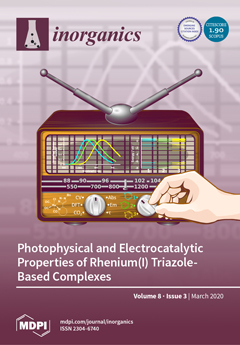A series of [Re(N^N)(CO)
3(Cl)] (N^N = diimine) complexes based on 4-(pyrid-2-yl)-1,2,3-triazole (
1), 1-benzyl-4-(pyrimidin-2-yl)-1,2,3-triazole (
2), and 1-benzyl-4-(pyrazin-2-yl)-1,2,3-triazole (
3) diimine ligands were prepared and their photophysical and electrochemical properties were characterized. The ligand-based reduction wave is shown
[...] Read more.
A series of [Re(N^N)(CO)
3(Cl)] (N^N = diimine) complexes based on 4-(pyrid-2-yl)-1,2,3-triazole (
1), 1-benzyl-4-(pyrimidin-2-yl)-1,2,3-triazole (
2), and 1-benzyl-4-(pyrazin-2-yl)-1,2,3-triazole (
3) diimine ligands were prepared and their photophysical and electrochemical properties were characterized. The ligand-based reduction wave is shown to be highly sensitive to the nature of the triazole-based ligand, with the peak potential shifting by up to 600 mV toward more positive potential from
1 to
3. All three complexes are phosphorescent in solution at room temperature with λ
max ranging from 540 nm (
1) to 638 nm (
3). Interestingly, the complexes appear to show inverted energy-gap law behaviour (τ = 43 ns for
1 versus 92 ns for
3), which is tentatively interpreted as reduced thermal accessibility of metal-centred (
3MC) states from photoexcited metal to ligand charge transfer (
3MLCT) states upon stabilisation of the N^N-centred lowest unoccupied molecular orbital (LUMO). The photophysical characterisation, supported by computational data, demonstrated a progressive stabilization of the LUMO from complex
1 to
3, which results in a narrowing of the HOMO–LUMO energy gap (HOMO = highest occupied molecular orbital) across the series and, correspondingly, red-shifted electronic absorption and photoluminescence spectra. The two complexes bearing pyridyl (
1) and pyrimidyl (
2) moieties, respectively, showed a modest ability to catalyse the electroreduction of CO
2, with a peak potential at ca. −2.3 V versus Fc/Fc
+. The catalytic wave that is observed in the cyclic voltammograms is slightly enhanced by the addition of water as a proton source.
Full article





